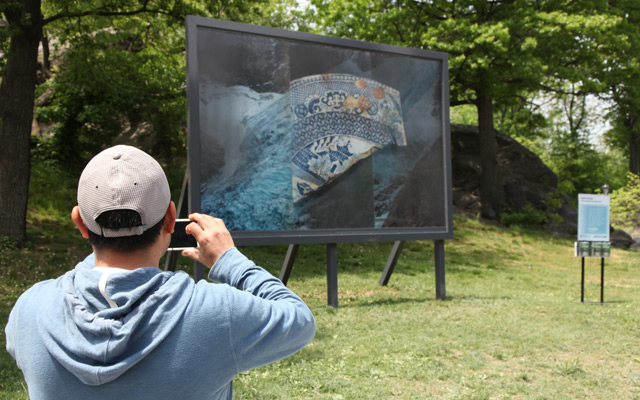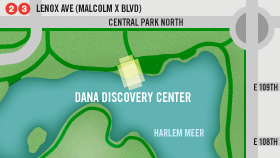About the Artworks and Artists

KARYN OLIVIER
Here and Now/Glacier, Shard, Rock is a sculptural billboard adjacent to the Harlem Meer that invokes and blends contrasting topographic and anthropologic histories of Central Park through shifting images of a glacier, a Seneca Village pottery shard, and rocks.
While many of us would like to believe that Central Park has been, and forever will be, a timeless paradise, Karyn Olivier’s work elegantly reminds us of the constantly mutable nature of the Park and its history. Sited on the banks of the Meer, a lenticular signboard displays an animated collage of images — a glacier, a pottery shard from an historic Central Park settlement and an image of the contemporary landscape — that seem to appear and disappear as the viewer adjusts perspectives. Together, these images provide a vision of the park’s past, present, and future.
Seneca Village was a significant Manhattan settlement founded by free black property owners in 1825. Its African-American, Irish, and German residents were displaced when the city claimed the right of ’eminent domain’ to purchase their properties and develop the Park for public use in 1857.
Special thanks to Cynthia Copeland, Nan Rothschild, and Diana Wall at the Seneca Village Project for granting access to the excavation archive.
PATH AROUND HARLEM MEER EAST SIDE OF PARK NEAR 106TH STREET ENTRANCE
ABOUT KARYN OLIVIER

Photograph courtesy the artist
Karyn Olivier is best known as a large-scale installation artist whose work manipulates ordinary spaces and everyday objects, intervening in “blind spots” to alter our perceptions of fixed forms and narratives. Olivier’s discrete rearrangement and dislocation of familiar subjects shifts our experience, asking us to reconcile memory with the present moment, and collapsing past, present and future. At times, this shaping/shifting of spaces allows the public to claim, reclaim or define a site in a new way. Olivier’s work often deals with themes of public and private space, and a collective nostalgia connected to shared social and physical experiences. The work sometimes asks for public participation—a kind of corroboration with the audience, creating temporary monuments that commemorate fleeting moments.

